1913: The U.S. Curie Standard
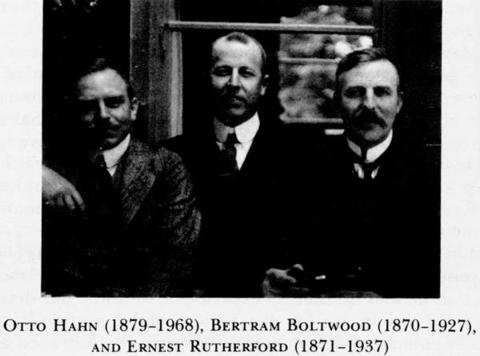
The International Radium Standards Committee met in Brussels in September 1910 in connection with the International Congress on Radiology and Electricity. The two most influential members of this committee were the Nobel prize winners Marie Curie and Ernest Rutherford. Rutherford had recently moved from McGill University in Montreal to the University of Manchester in the United Kingdom. Other members of the committee were Bertram Boltwood, a radiochemist from Yale University and close colleague of Rutherford; André Debierne, a colleague of Marie Curie's; Arthur S. Eve, a colleague of Rutherford's from McGill; Hans Geitel, a German physicist from Wolfenbüttel; Otto Hahn, a German chemist who had spent 1905 - 1906 with Rutherford in Montreal; Stefan Meyer, an Austrian physicist who was head of the Institute for Radium Research in Vienna; Egon von Schweindler, a German physicist; and Frederick Soddy, another collaborator of Rutherford's from McGill.
Marie Curie, who would soon receive a second Nobel prize, this time for chemistry, had strong ideas about the directions to take towards international standards. The first order of business of this committee was to agree to the quantity and unit for radioactivity. It was quickly agreed that the unit for radioactivity would be the Curie in memory of Pierre Curie, but there was considerable discussion over the amount of activity that would correspond to 1 Curie. (A working amount of radium at the time was of the order of a few milligrams of the element.) Marie Curie felt that it was inappropriate to use the name Curie for an infinitesimal amount of material, so she insisted that a Curie correspond to a larger amount. Her definition was "la quantité d'émanation en équilibre avec un gramme de radium." That is, that quantity of 222Rn (3.8 day half life) in equilibrium with one gram of its parent 226Ra.
The second order of business for the committee was to agree on an international standard that could be used to intercompare radium preparations from the principal laboratories in North America, UK, France, Germany and Austria. The preparation of a radium standard was assigned to Marie Curie, and in 1911 she prepared 21.99 milligrams of pure radium chloride in a sealed glass tube. The job of preparing multiple standards for distribution fell to a chemist, Otto Hönigschmid in Vienna, who was expert in gravimetric measurements and a leading authority on measurements of atomic weights.
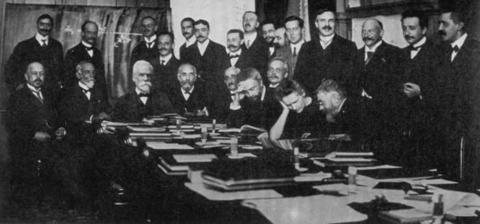
In 1911, Marie Curie and Ernest Rutherford met again at the First Solvay Conference on physics in Brussels. According to Rutherford, one of the top items on the agenda was discussion of the new radium standard. In March 1912, the committee met again in Paris to intercompare the Curie standard with three Vienna standards of RaCl2 prepared by Hönigschmid. The intercomparison was made by comparing the gamma-ray emission rates of the four samples. The Curie standard was stored at the Bureau International des Poids et Mesures (BIPM) in Sèvres in the Paris suburbs. Hönigschmid was then charged with preparing another set of standards for distribution to the metrology laboratories of several countries. The account of the U.S. national standard is best described in Noah Dorsey's own words:
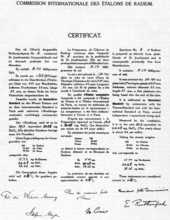
"The International Committee on Radium Standards also arranged for the preparation of standards for those governments that required them. These secondary standards are compared directly both with the International Standard in Paris and with the Vienna Standard. In December, 1913, the United States received its standard. It is designated by the Committee as 'Secondary Radium Standard No. 6,' and is certified to have contained in the autumn of 1913, 20.28 mg. of radium chloride, equivalent to 15.40 mg. of radium. This radium standard is preserved at the National Bureau of Standards at Washington, D.C., and is the primary radium standard of the United States. The radium content of all the working standards at the Bureau are determined by comparison with this. The certificate was signed by Stefan Meyer from the Institut für Radiumforschung in Vienna, Marie Curie and Ernest Rutherford. The certificate has three columns and the text is replicated in German, French and English. The radium in this standard had been obtained from pitchblende from St. Joachimstal in Bohemia."
Noah Dorsey
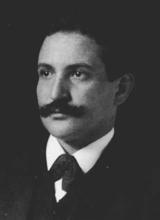
By the spring of 1914, the Bureau was calibrating radium preparations and radium emanations (222Rn) by comparison of submitted samples with the NBS Curie standard. The comparative gamma-ray measurements are described only in summary fashion in Dorsey's book. It is clear from the Director's Annual Reports from this period that the Radium Section performed a very large number of such calibrations annually. This large demand for calibrations was driven by the increasing use of radium and radon in radiation therapy. External beams of radium gamma rays were used in "radium helmets" in which several beams were focused on an isocenter for head and neck tumors. Radium needles and radon seeds (sealed glass bulbs containing the emanation from milligram quantities of radium) were used in what is still called in Europe, endocurietherapy. In the United States, it became known as brachytherapy (brachy- is Greek for "near"). One of the largest sources of radium in the United States was mineral deposits of carnotite from western Colorado and Utah. The Radium Company of Colorado and the Radium Refining Plant of the Standard Chemical Company of Pittsburgh were two of the commercial firms that relied on the Bureau for accurate measurements of their working standards.
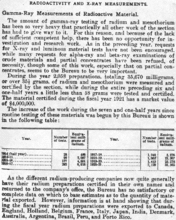
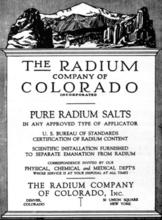
By the end of World War I, radium had increased in value to about $100,000 per gram, and, since it was so difficult to measure, there was a serious problem with fraudulent suppliers. One of the main jobs of the Bureau during those early years was to assay purported radium preparations to assure the buyers that the samples contained the stated amounts.

